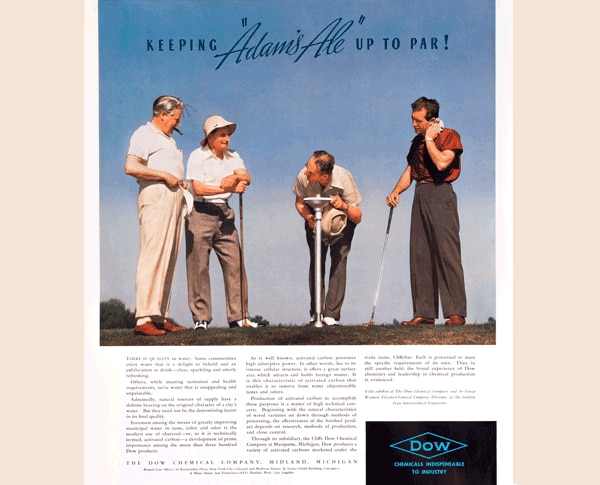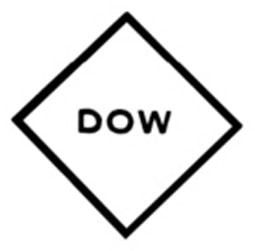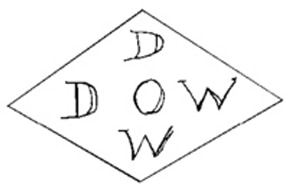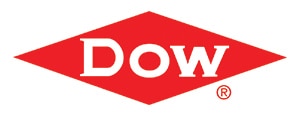
Innovation Builds a Company.
Advertising Tells the Story
A Look Back at Dow’s Vintage Advertising
Dow has used advertising since the early 1900s to sell various products, attract employee candidates, and share its mission and values. But just as the Company and its products have evolved over the last century, so have Dow ads.
Getting into the Direct Sales Game: Dow’s First Advertisements
Before 1905, Dow used third-party sellers to market all its products. But once the decision was made to begin direct sales of bleaching powder, they knew they needed to staff a “Selling Department.” So the first Dow official print advertisement, placed in a regional New York publication in 1904, was a blind ad (it didn’t mention the Dow name) seeking potential employee candidates for a sales manager position in Midland, Michigan.
To support the new direct sales approach, the following year the Company began running advertisements in the trade journal Oil, Paint, and Drug Reporter, so industrial buyers looking for bleaching powder from Dow would become “accustomed to the change.” These ads were the first advertising campaign that mentioned Dow by name.
The ads carried the Dow name, but not the Company’s logo. The DOW® Diamond, well recognized around the world today, wasn’t developed for another decade and only took shape after Herbert H. Dow began sketching out designs. But by 1919, the logo was commonplace in the Company’s advertisements; it was officially registered with the U.S. Patent Office in 1921. It has remained virtually the same over the years, with only minor tweaks. (See sidebar.)
Moving the “MAG-nificent” Metal: A National Pitch for a New Product
In the late 1900s, Dow developed a magnesium alloy that was lighter than aluminum, but had similar strength and performance. Alloy No. 98, named for its place within the lab test series and touted as the “MAG-nificent” metal, was later given the official brand name of DOWMETAL and introduced to the automotive aftermarket for pistons.
To help grow the business, Dow worked with auto mechanics across the country, engaging them to install the new alloy pistons in their customers’ cars. Once that national network of authorized auto mechanics was in place, Dow began advertising the superior automotive engine performance and speed enhancements for cars using DOWMETAL alloy pistons. This first national ad campaign for Dow encouraged car owners to visit their local automotive garages to have these new pistons installed.
From Plastics to Bubbles: Dow’s Post-World War II Consumer Push
At the end of the second World War, citizens of the United States were trying to get back to a sense of normalcy after a decade of sacrifice and economic hardship. Many companies that had been supplying the war effort, including Dow, were suddenly faced with excess production capacity. Although typically a business-to-business company, Dow sought opportunities to sell its products directly to consumers.
Dow embarked on a major consumer push during the 1940s and 1950s, connecting its plastics materials and products with everyday household needs – from food preservation and presentation to toys. This trend continued into the 1970s, and along the way advertising moved into new media like television. Soon, items like Saran Wrap® and Dow Bathroom Cleaner with Scrubbing Bubbles™, became nationally recognized. “Dow” was now becoming a household name.
Science, Sustainability and Solving Human Challenges
As Dow has transitioned to being primarily a science and technology leader over the past two decades, its advertisements have changed along with it to focus on providing solutions to the world’s most difficult challenges. From energy-efficient materials that reduce greenhouse gas emissions to technologies that increase access to clean water, Dow corporate advertising focuses on the positive possibilities of science.
In 2006, Dow launched its award-winning Human Element campaign. The ads featured stunning photography and messaging that put a human face on technical solutions. In 2012, Dow’s “Solutionism: The new optimism” campaign – part of Dow’s broader Human Element campaign – used whimsical images like feathery windmills and a giant drinking straw to illustrate solutions for more efficient renewable energy and filters for drinkable water. In 2014, new Dow ads celebrated the “Human Element at Work” by highlighting how Dow employees, working together, improve the human condition. The integrated campaign featured Dow scientists in television spots, print ads, web videos and social media.
Because the Human Element campaign has had storytelling at its heart, it has proved to be versatile and long-lived, said Michael Kolleth, director of corporate advertising and branding at Dow. “The ‘Human Element’ campaign creates a synergy between two of Dow’s core priorities — solutions based in science and a purpose focused on humanity. It illustrates how Dow people are the missing component on the Periodic Table of Elements, working with others to meet the most basic human needs.”
Dow’s Evolving Story: An Advertising Retrospective
The story of each company is often reflected in its advertising and Dow’s story is no exception. As a look through the last century or more of Dow’s advertising shows, Dow has evolved to meet the changes of society and the customers the Company serves.

First Dow Product Ad with the DOW Diamond, 1918
The first ad to carry the DOW Diamond, placed in Oil, Paint, and Drug Reporter, advertised manufacture and prompt shipment of chemicals important to textiles, pharmaceuticals and other industries –a far cry from the Company’s single-product beginnings.

Vintage water purification ad, 1939
The allusion in the headline for this ad might be lost on today’s reader: Adam’s Ale is an archaic colloquial expression that means unadulterated water. Combined with a newly minted “indispensable to industry”tagline, this ad seeks to connect municipal water purification to a carefree lifestyle promoted in much prewar advertising in the United States, including Dow’s.

Vintage Texas Division ad, 1945
Just four years after Dow first extracted magnesium from seawater, Texas was a “ranking source of magnesium and chemicals.” This wartime Texas Division ad shows the Company’s pride in the booming site and extends Dow’s “indispensable” ad series to chemicals indispensable to industry and victory.
A Diamond in the Rough
Speculation on the origin of the DOW Diamond goes back to shipping barrels being marked with four slashes in the shape of a diamond. “Dow” was placed in the middle. Over nearly 100 years, the Diamond continued to evolve and become an important part of Dow’s visual identity.

In 1898, M.B. Johnson, Dow’s first operations superintendent, used a Dow-in-diamond mark to help resolve product shipping problems.

By 1918, the symbol was used as a corporate mark. Sketches in Herbert H. Dow’s notebooks suggest early design concepts, including type treatment.

In 1970, different colors were used based on geographies. Yellow was used for Asian countries, blue for Europe and green for Pacific countries. The red DOW Diamond was reserved for North America.

In 1990, guidelines outlined proper use of the DOW Diamond, specifying Pantone 185 Red for all external correspondence.
®Saran Wrap is a trademark of S.C. Johnson and Son, Inc.
™Scrubbing Bubbles is a trademark of S.C. Johnson and Son, Inc.
Pantone® and PANTONE MATCHING SYSTEM® are registered trademarks of PANTONE, Inc.
Contact us
Have a question or need more information about Dow Corporate? We have multiple ways to help you get the answers you need.





